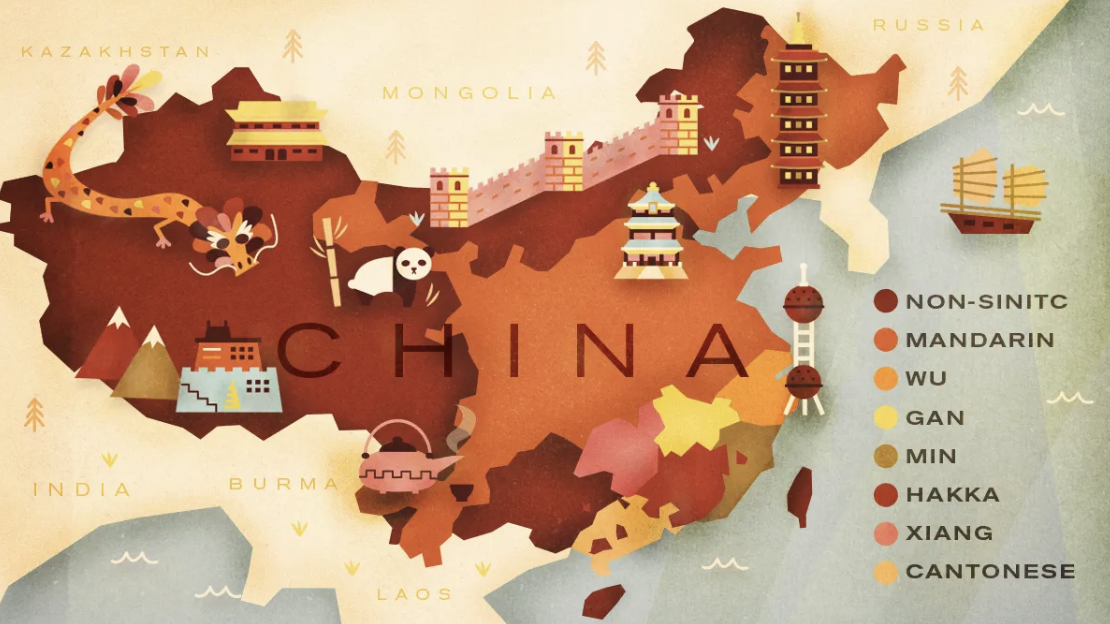
Exploring the Colorful Diversity of the Chinese Language
You’ve probably heard of Mandarin and Cantonese, but did you know there isn’t just one Chinese language? Instead, there are many dialects and languages that form a continuum of intelligibility. These dialects are all part of the Sino-Tibetan language family. However, some languages spoken in large parts of China don’t belong to this family at all.
In fact, Mandarin Chinese alone is the most widely spoken native language in the world: nearly a billion people in China and 1.2 billion worldwide—more than a few hundred million people more than the next most widespread languages, Spanish and English (Asia Society). Let’s explore this fascinating linguistic diversity!

Picture credit: Babbel
Mandarin vs. Cantonese
When people talk about “Chinese,” they usually mean Mandarin or Cantonese.
Mandarin, or 普通话 [pǔtōnghuà], is the official language of China and the one spoken by most Chinese people.
However, if you visit Guangdong province or the vibrant city of Hong Kong, you’ll hear Cantonese, or 广东话 [Gwóngdūng wá]. Spoken by nearly 70 million people, Cantonese is the second most spoken language in the Sinitic family (the group that includes both Cantonese and Mandarin).

What Makes Them Different?
Pronunciation: Cantonese and Mandarin differ greatly in pronunciation. Cantonese has nine tones, while Mandarin has only four. This means that the tone used can completely change the meaning of a word in Cantonese, while in Mandarin, the tone change usually alters the meaning.
Grammar: Cantonese has more complex grammar than Mandarin. It uses more particles and has a more detailed system of verb tenses and aspects.
Vocabulary: While Mandarin and Cantonese share some vocabulary, they also have unique words. Cantonese has many loanwords from other languages, whereas Mandarin has more loanwords from classical Chinese.
Minority Languages
Besides Mandarin and Cantonese, China is home to many other Sinitic languages. Here are a few examples:
-
Hokkien (Minnan): Spoken by around 60 million people in Fujian province.
-
Shanghainese (Wu): Spoken by about 14 million people in Shanghai and surrounding areas.
-
Min Dong: A dialect spoken by 2.5 million people in eastern Fujian.
-
Hakka: Spoken by 35 million people in southern China.
-
Gan: Spoken by 20 million people in Jiangxi province.
-
Xiang: Spoken by 38 million people in Hunan.
-
Jin: Spoken by 33 million people in Shanxi, Henan, and Hebei.f
-
Kejia (Hakka): Spoken by 24 million people in Guangdong and Fujian.
These numbers are approximate and can vary based on the source. Additionally, many of these languages have sub-dialects spoken by different ethnic groups.
Chinese Languages Outside the Sinitic Family
While most of China speaks a Sinitic language, large groups of people speak languages from other families. The three most notable are:
-
Tibetan: Spoken by 6 million people in the Tibet Autonomous Region, Sichuan, Yunnan, and Qinghai provinces. It belongs to the Tibeto-Burman language family and is the official language of Tibet.
-
Mongolian: Spoken by 5 million people in Inner Mongolia. It is part of the Mongolic language family and is the official language in Inner Mongolia.
-
Uighur: Spoken by 10 million people in Xinjiang Uighur Autonomous Region. It is a Turkic language and one of the official languages of Xinjiang.
Interestingly, these regions are also the most autonomous in China.
Conclusion
So, is there just one Chinese language? No, China is home to a rich tapestry of languages. When people refer to “Chinese,” they often mean Mandarin, but the country is full of linguistic diversity. Mandarin has become the default language for communication, but if you meet someone from China, or are taking Mandarin courses with LanguageBird, ask if they speak a regional dialect or language. You’ll be amazed by China’s linguistic variety!



